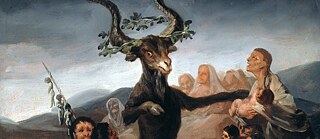Sleep Paralysis
1:00 p.m., Paralyzed and Suffocated
Haunted by shadowy beings and Pan, the god of shepherds, the body sleeps, but the mind is wide awake. A state that is better than its reputation.
I leap through the window.
Shards crunching under my feet,
outside it’s snowing in the summer.
I clamber over the fence,
my face scratched, ignoring the shots.
I climb down into the sewers through an open manhole and conceal myself in a small niche beside the ladder leading further down. There’s a small curtain in front of the niche, white and peaceful, I draw it shut. No stench of excrement, an odorless state.
As the authorities climb down the ladder right past me I can see their shadows through the curtain. I lie in the niche in the fetal position and hear the steps, I hear the breathing of others, but not my own. My limbs are paralyzed. My sense of touch is deactivated. I can see but my eyes do not open. I cannot breathe, but I do not suffocate.
I dropped off to sleep sometime around noon from sheer exhaustion brought about by wage labor and depression; I woke shortly after 1:00 p.m. with adrenaline coursing through my body due to symptoms of suffocation and paralysis.
Medical websites have long since tapped into the phenomenon of sleep paralysis, as have Der Spiegel, Deutschlandfunk, and programs for young people on public broadcasting. It is a rewarding topic, after all, a horror film produced by the body itself. Fragmented images, a rabbit hole, sleep paralysis:
Once upon a midnight dreary, while I pondered, weak and weary,
Over many a quaint and curious volume of forgotten lore —
While I nodded, nearly napping, suddenly there came a tapping,
As of someone gently rapping, rapping at my chamber door.
“’Tis some visitor,” I muttered, “tapping at my chamber door —
Only this and nothing more.”
Presumably, the first-person narrator in Poe’s poem also suffered an episode of sleep paralysis, having perhaps overtaxed himself with the quaint and curious volumes. The question, however, is: Why think of Poe at all or of any devilish goat-like creatures or huge cats for that matter when discussing the subject of sleep paralysis? It would surely be better to think about Mark Fisher, who writes in Capitalist Realism that capitalism has colonized even our dreams, and whose writings also explore the lack of access to psychotherapeutic help. Or about Heike Geissler’s book Seasonal Associate in which she describes exploitative structures in an Amazon fulfillment center in Leipzig and the physical and psychological exhaustion that results from the robotic monotony of such work.
What is sleep paralysis anyway? A state of physical stasis during which the mind is awake, and the body’s surroundings keep moving. And thus, perhaps, the only state of wakefulness that does not ultimately constrain us, that cannot be utilized for any specific purpose, and that forces those affected not to function at all for once.
Or, to put it another way, the human skeletal muscles are paralyzed during REM sleep to prevent us from moving unnecessarily while dreaming intensively, as this might cause us to injure ourselves. Sleep paralysis is the result of too rapidly transitioning from REM sleep into wakefulness. The mind wakes up more quickly than the skeletal muscles, giving rise to paralysis, the sense of respiratory distress, panic, the shadowy beings. Though entirely harmless, and probably the least dangerous near-death experience of all, this is nonetheless a symptom of what Fisher and Geissler describe.
The causes of sleep paralysis can include stress and psychological disorders. So, why not accept the horror and view it as something positive instead? As a state of standstill that warns us and reminds us that it is more important to take some time off or seek therapy than to surrender to the rat race and continue to compete at all costs.
Two tracks on Ziur’s 2017 album U Feel Anything? represent two possible ways to view the stasis induced by sleep paralysis. It can be perceived as a brutal and hopeless horror scenario to escape by any means necessary, like in the unwieldy track “Arise.” Alternatively, however, there’s the interpretation outlined in the track “Body of Light,” which hints at nightmarish sounds but ultimately gives way to beautiful and synthetic tones in a moment of clarity. It is reminiscent of the angst-filled 1:00 p.m. awakening from a state of paralysis, but it also allows space for thoughts about how horror does not, in fact, lie in a brief period of standstill, but rather in the reality that the mind is suddenly thrust back into — and that needs to be changed in the first place.
This article was commissioned by and created in collaboration with Das Wetter – Magazin für Text und Musik.
Shards crunching under my feet,
outside it’s snowing in the summer.
I clamber over the fence,
my face scratched, ignoring the shots.
I climb down into the sewers through an open manhole and conceal myself in a small niche beside the ladder leading further down. There’s a small curtain in front of the niche, white and peaceful, I draw it shut. No stench of excrement, an odorless state.
As the authorities climb down the ladder right past me I can see their shadows through the curtain. I lie in the niche in the fetal position and hear the steps, I hear the breathing of others, but not my own. My limbs are paralyzed. My sense of touch is deactivated. I can see but my eyes do not open. I cannot breathe, but I do not suffocate.
I dropped off to sleep sometime around noon from sheer exhaustion brought about by wage labor and depression; I woke shortly after 1:00 p.m. with adrenaline coursing through my body due to symptoms of suffocation and paralysis.
Medical websites have long since tapped into the phenomenon of sleep paralysis, as have Der Spiegel, Deutschlandfunk, and programs for young people on public broadcasting. It is a rewarding topic, after all, a horror film produced by the body itself. Fragmented images, a rabbit hole, sleep paralysis:
- A black figure appears
- Hallucinations of horror
- Being haunted by nightmarish apparitions
- Being haunted by Pan, the god of shepherds
- Studies show that different apparitions appear depending on the culture: witches and huge cats in Italy, djinns in Egypt, shapeless shadowy beings in Denmark
- Reports of conditions similar to those in Edgar Allan Poe’s horror stories
Once upon a midnight dreary, while I pondered, weak and weary,
Over many a quaint and curious volume of forgotten lore —
While I nodded, nearly napping, suddenly there came a tapping,
As of someone gently rapping, rapping at my chamber door.
“’Tis some visitor,” I muttered, “tapping at my chamber door —
Only this and nothing more.”
Presumably, the first-person narrator in Poe’s poem also suffered an episode of sleep paralysis, having perhaps overtaxed himself with the quaint and curious volumes. The question, however, is: Why think of Poe at all or of any devilish goat-like creatures or huge cats for that matter when discussing the subject of sleep paralysis? It would surely be better to think about Mark Fisher, who writes in Capitalist Realism that capitalism has colonized even our dreams, and whose writings also explore the lack of access to psychotherapeutic help. Or about Heike Geissler’s book Seasonal Associate in which she describes exploitative structures in an Amazon fulfillment center in Leipzig and the physical and psychological exhaustion that results from the robotic monotony of such work.
What is sleep paralysis anyway? A state of physical stasis during which the mind is awake, and the body’s surroundings keep moving. And thus, perhaps, the only state of wakefulness that does not ultimately constrain us, that cannot be utilized for any specific purpose, and that forces those affected not to function at all for once.
Or, to put it another way, the human skeletal muscles are paralyzed during REM sleep to prevent us from moving unnecessarily while dreaming intensively, as this might cause us to injure ourselves. Sleep paralysis is the result of too rapidly transitioning from REM sleep into wakefulness. The mind wakes up more quickly than the skeletal muscles, giving rise to paralysis, the sense of respiratory distress, panic, the shadowy beings. Though entirely harmless, and probably the least dangerous near-death experience of all, this is nonetheless a symptom of what Fisher and Geissler describe.
The causes of sleep paralysis can include stress and psychological disorders. So, why not accept the horror and view it as something positive instead? As a state of standstill that warns us and reminds us that it is more important to take some time off or seek therapy than to surrender to the rat race and continue to compete at all costs.
Two tracks on Ziur’s 2017 album U Feel Anything? represent two possible ways to view the stasis induced by sleep paralysis. It can be perceived as a brutal and hopeless horror scenario to escape by any means necessary, like in the unwieldy track “Arise.” Alternatively, however, there’s the interpretation outlined in the track “Body of Light,” which hints at nightmarish sounds but ultimately gives way to beautiful and synthetic tones in a moment of clarity. It is reminiscent of the angst-filled 1:00 p.m. awakening from a state of paralysis, but it also allows space for thoughts about how horror does not, in fact, lie in a brief period of standstill, but rather in the reality that the mind is suddenly thrust back into — and that needs to be changed in the first place.
This article was commissioned by and created in collaboration with Das Wetter – Magazin für Text und Musik.







